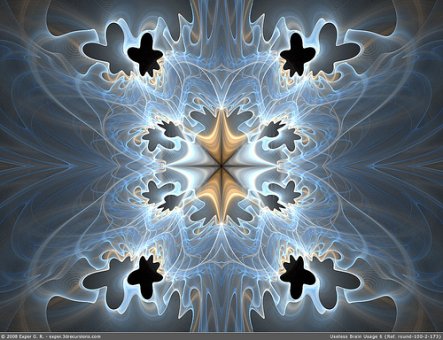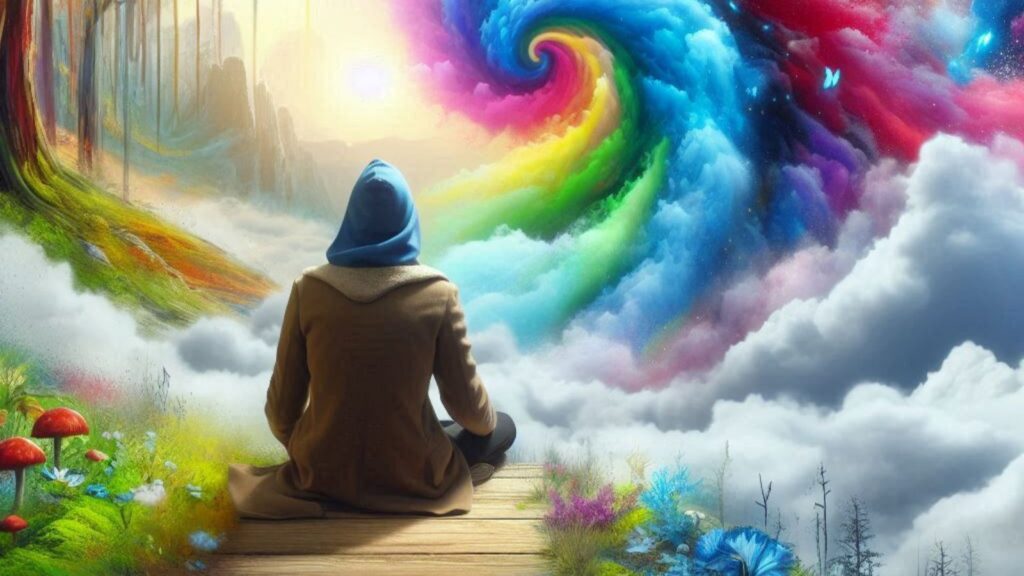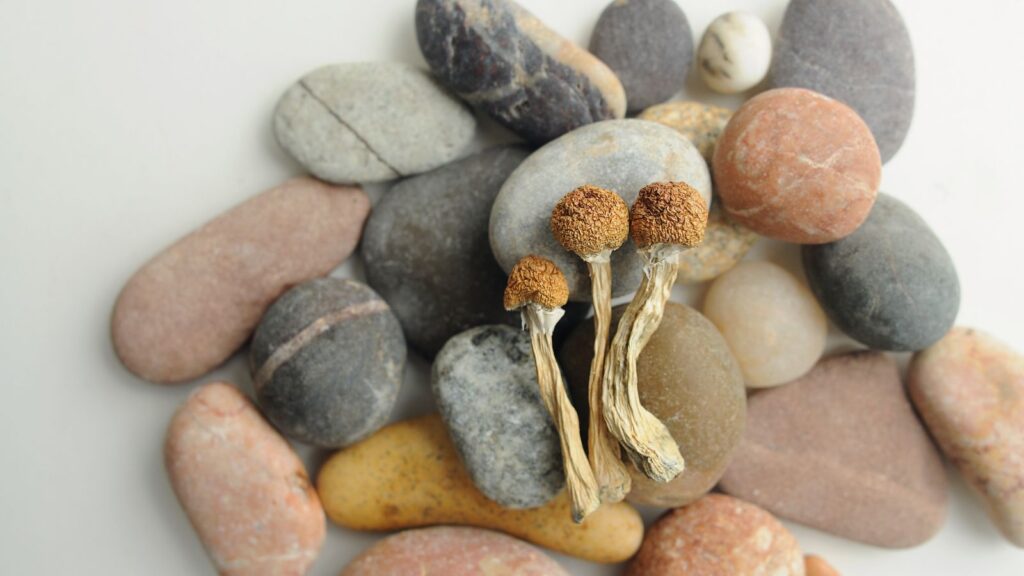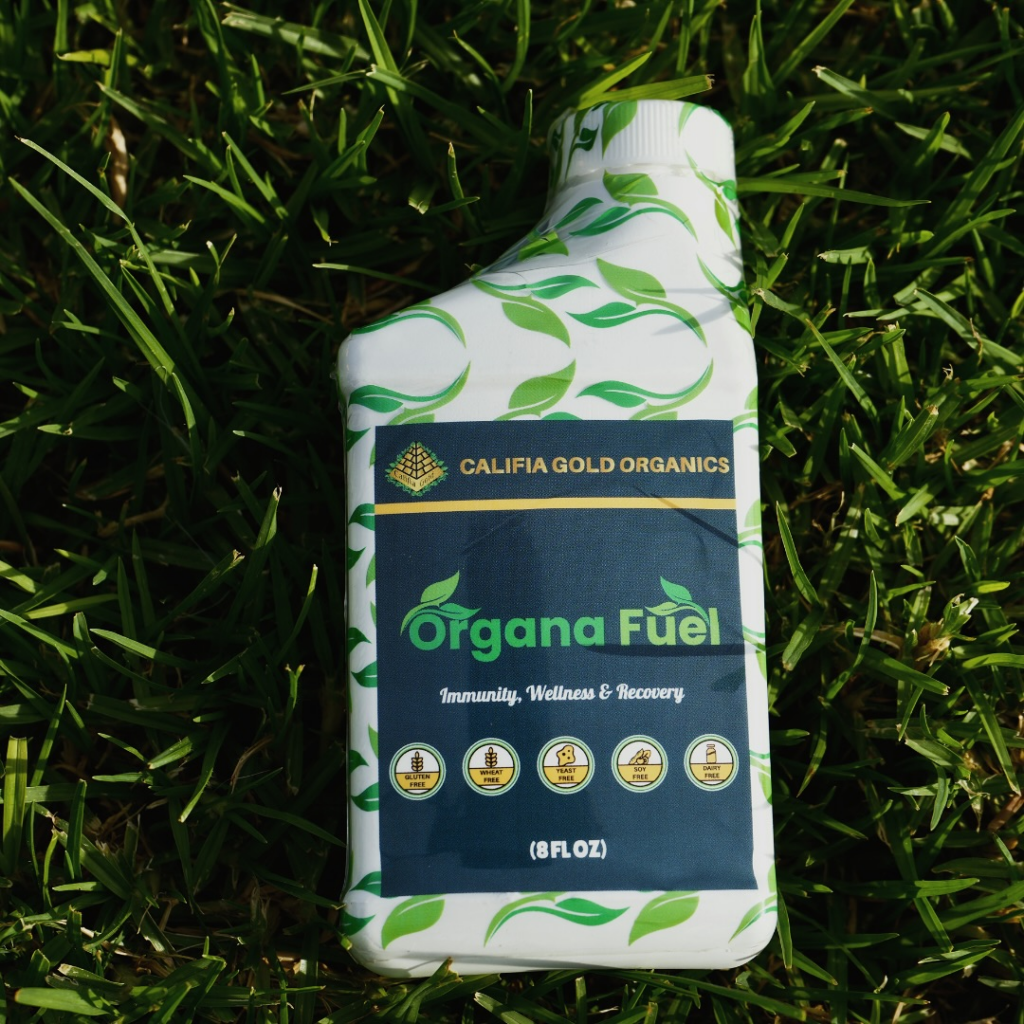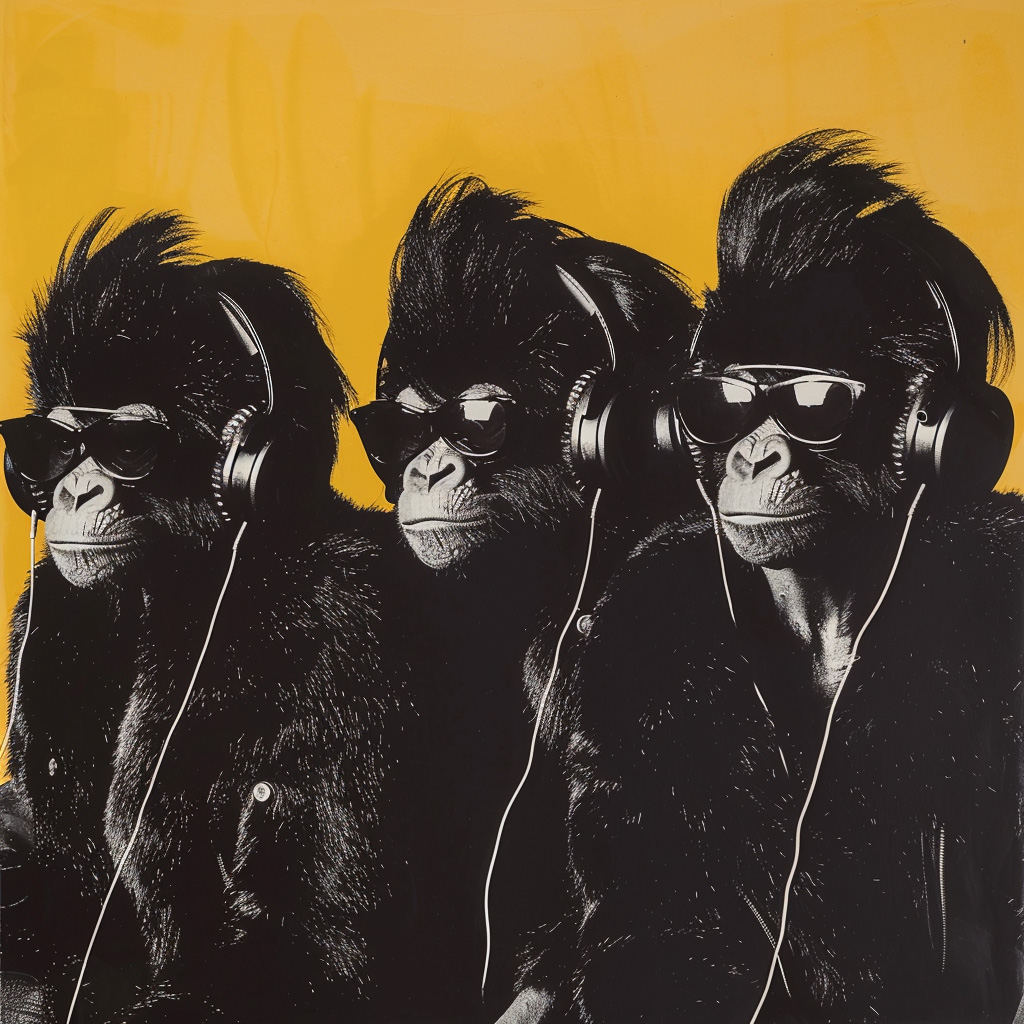The following is an excerpt from The Eight-Circuit Brain: Navigational Strategies for the Energetic Body, forthcoming from Vertical Pool Publishing.
“We soared, we crashed, we burnt out, we’re tuning back in.”
We are all walking through the pages of our own stories every day, stories that intersect the stories of others, dead and alive, as chapters in the larger Book of Life. If you are friends with writers, your story will probably end up in their writings or in their books some day, whether you like it or not. Even if you have never met the author of a book or read the book itself, your story is probably already captured. This happens all the time. And no matter how much certain authors write from their own personal experience, they cannot help but also reveal the greater truths innate to the collective milieu we are all expressions of. Some of these writers seem to have built-in broadband antennae for picking up those signals and decoding them for the rest of us; Timothy Leary was one of these big antennae writers.
Large collective shifts have ways of grabbing our personal lives by the scruff of the neck and tossing us about as if we were plastic action figure replicas of ourselves. Sometimes these greater forces erupt from deep within our own genetic makeup and shock us with diseases unexpectedly inherited from our ancestors. Other times, we get lucky and the chaos gods of the zeitgeist decide it’s our turn to win the lottery. Or when Aphrodite Love comes to town and turns our lives upside down in the name of Polymorphous Rapture.
These “outside shocks” can be humbling to any naive ego still in denial of the objective truths (and shocks) of Ecstasy, Uncertainty, Indivisibility and Impermanence. Thanks to Dr. Leary’s Eight-Circuit Brain model, I learned to see these shocks as activation points for what he calls fifth, sixth, seventh and eighth circuits, respectively. As it turns out, we all have antennas to pick up the big signals. We only have to learn how to unwrap them from ourselves, our self-absorption, and point them outwards again.
In video-blogger Brian Shields’ interview with Lisa Ferguson (2/8/2009 at the Timothy Leary reunion party, 111 Minna gallery in S.F.), she shares a startling message from Leary himself, spoken to her personally three days before his death. “We were right,” he told her, “all the ideas and dreams we had back then, we were right. It’s time to tune back in.” Lisa took his message to heart as a boost to complete her documentary film, “Children of the Revolution.” Inspired by her own Millbrook childhood stories where her baby sitters were none other than Tim Leary, Ralph Metzner and Richard Alpert (Ram Dass), the film also features interviews with other sixties luminaries and what they are tuning into today. Watch for it!
Those who were not alive to witness or participate in the sixties cultural revolution first hand may feel a sense of having missed out on something important and/or harbor the more cynical belief that the world is worse off thanks to Baby Boomer’s self-indulgent delusions of entitlement that got us into the mess we’re in today. As with many polarized views, the truth often lies somewhere in between. It is now well documented that the American media and government created and maintained the illusion that the sixties were a failed experiment in drug abuse, sexual debauchery, and impossible utopian ideals. And in one sense they were right. Literally millions of participants in this cultural experiment soared, crashed, burnt out, and lost all perspective by pursuing overly inflated, narcissistic visions of changing the world with more peace, love, sex, and LSD.
I can only assume that most utopian visions fail from apathy due to a lack of the consistent self-discipline necessary to embody the vision and “become the change we want to see in the world.” Any full-blown spiritual event, with or without LSD, can naturally expose the futility and the illusion of ego. In a naive attempt to preserve spiritual revelation, many ego-trashing dogmas have been created. Taken to heart, any anti-ego hippie belief can easily lead to a “why bother?” apathy masked by a “just mellow out and go with the flow” fatalism. As it turns out, a strong, flexible ego is necessary to manifest our innermost dreams in the external world at large. Any attempt to hold onto a dream, without the self-work to embody it, keeps that dream alive in the mind alone. And in the sixties, LSD opened up millions of minds and more specifically, millions of third eyes (sixth circuit). This powerful cultural and psychic event also catalyzed equally potent somatic, body-centered experiences through the sixties’ sexual revolution. LSD can also make us very horny.
The sixties were not a failed experiment. The sixties wrote the first chapter in an ongoing book of how culture transforms itself starting at the level of the individual. In this chapter, an all-encompassing epiphany of self-awareness explodes in the brain and exposes the nature of reality itself. This event can easily overwhelm the existing means to contextualize and apply this knowledge, especially if we are spiritually starved and cannot stop eating fruit from the tree of cosmic knowledge. We eat, we rest, we talk and dream of future societies, and then we eat some more and talk some more. The more forbidden fruit we eat, the more our minds expand and enflame the search for what it all means, ad infinitum and ad nauseum.
“Existence itself may be considered an abyss possessed of no meaning. I do not read this as a pessimistic statement but a declaration of autonomy for my imagination & will and their most beautiful act of bestowing meaning upon existence itself.” — Hakim Bey
The use of LSD and other psychoactive agents not only shocks the ego with exposure to the void but also shocks the very core of our being with a direct experience of void as true nature, who we are at essence, a stunning revelation brought to collective consciousness centuries ago by Gautama Buddha (and given collective context through the creation of various schools of Buddhist meditation practice, doctrine and dogma. I think of Timothy Leary as a Buddha or, as he might prefer to be called, an MVP (Most Valuable Philosopher) of the 20th Century. And like other great philosophers before him, it’s reasonable to assume that his seminal contribution may take forty or fifty years to find a collective and cultural context.
Even though Leary indirectly turned millions of people on to LSD, that phenomenon was clearly beyond his control. It was not his central contribution. His seminal offering persists as his Eight-Circuit Brain model for Intelligence Increase, a user-friendly grid designed for anyone exploring higher consciousness as a means not merely to get high, but for designing and creating new contexts for their lives. At the heart of the Eight-Circuit Brain model we find the two most important questions any self-aware person can ask: 1) What is intelligence?, and 2) According to your definition, how would you increase this intelligence?
I first encountered Leary’s Eight-Circuit Brain model in Bob Wilson’s ground-breaking book, Cosmic Trigger. Leary’s grid struck me with awesome potential. Here was a way of redefining “intelligence” through eight different yet related modalities that — when fully absorbed, integrated and transmitted — could possibly increase one’s intelligence as eight brains in a neurological clusterfuck of Eternal Humming Delight. My twenty-seven year old mind was set ablaze as the seed was planted for writing my first book, Angel Tech.
Berkeley, California 1979-82: During one of Robert Anton Wilson’s many Discordian Salons, I shared with him my passion for Leary’s circuit system. I told him I’d like to write a book about it and apply my background in theatre to create rituals to help activate these “circuits” for the reader. Bob laughed and said it was a great idea. He then proceeded to tell me that he was writing a book along similar lines called Prometheus Rising, and that it might be the most important book he had written so far. I sat there dumbfounded as Bob’s gaze shifted towards his good friend, Greg Hill (author of Principia Discordia) who winked back at him. The Famous Published Author was writing his next masterpiece while an unknown theatre rat was in the wings scribbling notes for his, as of yet, unwritten and unpublished first book. A confusion of emotions. How could I feel so damn self-important and utterly insignificant at the same time? Operation mindfuck was in full swing.
I went home that night and started reading Leary’s book, Exo-Psychology. About seventy pages in, Circuit 3 intellect stuttered and choked before it finally shut down. Information overdose. So many theories, so little application. If I can’t apply knowledge in some way, it feels useless to me. For all of Leary’s brilliance and innovation, I was annoyed by what felt like a serious imbalance between theory and praxis. I asked Bob about this and he said “people might understand Tim better if they knew his nickname during his Harvard days: Theory Leary; he had reams and reams of them.” I decided that Angel Tech had to include numerous ways to substantiate a more direct experience of what the “circuits” symbolized. Direct experience trumps the armchair philosophy of abstract rationalizations. The Dogma of Direct Experience. I found my new dogma, though I didn’t know it was a dogma back then. Dogmas can be like that.
Four years later, Prometheus Rising is published. Bob’s encyclopedic funhouse genius advances Leary’s theories by linking them to a web of isomorphic systems, memes, and paradigms like Quantum Mechanics, B.F. Skinner’s Behaviorism, Korzybski’s Semantics, Sarfatti’s Superluminal Physics, Alan Watts’ Zen, Freud, Rattray Taylor’s Patrist/Matrist Sociology, and Toffler’s Third Wave. Bob also broke the Theory Leary Barrier by slyly inserting a series of tasks, word games, exercises and meditations aimed at triggering a more direct experience of the sources of intelligence inferred by the Eight-Circuit Brain model. In this book, Bob advances Leary’s theories for the postmodern Western central nervous system. This breakthrough also meant that in writing Angel Tech, I had to carry the ball further into terra incognito and descend deeper and deeper into the flesh and blood embodiment of these ideas.
Though Timothy Leary is publicly credited with the creation of the Eight-Circuit Brain model, he actually did not originate it but popularized his own updated version of an ancient Eastern spiritual code and practice. In the preface of his 1976 book, What Does Woman Want?, Dr. Leary explains how “Dr. Adams,” a Hindu scholar from Rutgers University, arrived at his Millbrook estate in the early sixties and initiated him to an esoteric practice of the Hindu Chakra System. Dr. Leary fully absorbed and assimilated this new teaching by replacing “chakra” with the modern term “circuit” and adding Western scientific terms plus recent breakthroughs in Genetics and Quantum Physics towards the transmission of his opus, Exo-Psychology (Starseed Press; updated to Info-Psychology, New Falcon).
The ancient yoga of the Hindu Chakra system aims at trans-substantiating consciousness through the energy centers of the body’s spinal column and brain. From the coarsest, densest, and slowest vibrational frequencies of the Muladhara root chakra (the coccyx) to the most refined, subtle and fastest vibrations of the Sahasrara crown chakra (the skullcap), a vertical pathway has been thoroughly and meticulously mapped out centuries ago infusing a priori status on the crown chakra as a final resting place for “The Enlightened.” Over years of meditation and yoga practice, the yogi learns to ignite the fiery kundalini coiled in the root chakra. When activated, its white-hot liquid fire pulses and hisses its way up the spinal column, blissfully burning through each chakra on its serpentine pathway toward the crown where it explodes into a “thousand-petalled lotus,” a luminous fountain of cosmic consciousness, establishing spiritual Guru status for the aspiring yogi.
This distinctly Eastern process of trans-substantiation moves consciousness beyond the finite domain of the physical body toward communion with The Infinite, an act that sanctions a disembodied spirituality in many Guru/Sunyasin traditions. The Guru’s expansive presence magnetizes scores of sunyasins, or devotees, who act as his “anchors” in the material world to assist the business of daily survival and to act as vessels for his vision, message, and spiritual presence. A deeply symbiotic bond develops as a mutually embraced dependency; the guru needs disciples as much as the disciples need the guru. Examples include Da Free John, Rajneesh (Osho), Muktananda, Maharaji Ji and many others.
Far from these Eastern religious traditions of trans-substantiation, western classical mythology points to the wily Titan Prometheus who steals fire from the chief god Zeus and gives it away to mortals for their personal use. This “stealing fire from the gods” story also appears in Native American tribal dreams and myths. According to the Cherokees, when Possum and Buzzard failed to steal fire, Grandmother Spider used her web to steal the fire, hiding it in a clay pot. Fire was also stolen and given to humans by Coyote, Beaver, or Dog. To the Creek Indians, Rabbit stole fire from the Weasels. Timothy Leary embodied this promethean mythos by stealing the fire from the Eastern gods and passing it onto the more materialistic and rebellious Western mind.
Beside updating archaic terms to postmodern sciences and terminologies, Leary introduced a significant breakthrough that bridged the Eastern bias of trans-substantiation to the Western substantiation bias, or materialization, of energies. He did this by basing his definition of intelligence on the biological model of the neuron. As the most basic unit of biological intelligence, the neuron functions by absorbing signals, storing or integrating them, and transmitting the results. He suggested that each of the eight functions of intelligence, symbolized by the Eight-Circuit Brain, could only be fully experienced through their absorption, integration, and transmission, and on their own terms.
He also suggested that intelligence would remain latent or repressed to the degree that we were unable or unwilling to fully absorb, integrate, and transmit it. This implies that simply absorbing data or experience alone cannot advance intelligence. Or put another way, who will know how intelligent we really are until we have integrated our experiences enough to express, share, and articulate them? If we apply this tertiary principle — of Absorb, Integrate and Transmit — to all eight functions of this model, the implications are staggering.
If all perceptions are gambles, as Bob suggests, the Eight-Circuit Brain model remains one of the most eloquent and thrilling ways to play the cards I’ve been dealt. Bob also used to say, “The future is up for grabs. It’s too late for anything but Magick.” I think the future has already happened. The future is now. Spread the word. Prometheus has risen. Life itself is the guru.
The Four Survival Circuits: Their Fixations and Anchors
Each of the first four “survival circuits” are driven by variations on the primary will to survive. Fixations refer to any concentration and investment of consciousness in specific events and experiences that activate a given circuit. Fixation also demonstrates how consciousness can become fixed, or “stuck,” in one circuit over another by overemphasis. Anchors refer to how we know a circuit has been earned and integrated and is ready to serve as a stabilizing influence, or anchor, for absorbing and integrating the shock from its higher overtone function (1 & 5, 2 & 6, 3 & 7, 4 & 8; more on this later).
C-1 Physio-Biological Intelligence; the will to survive fixations: food, shelter, self-preservation, material goods, safety and security.
Anchor: degree of confidence earned and maintained to assure physical survival.
C-2 Emotional-Territorial Intelligence; the will to power fixations: self-defense, territoriality, status, ego-strength, emotional honesty.
Anchor: degree of emotional confidence earned and maintained to assure personal worth.
C-3 Symbolic-Conceptual Intelligence; the will to sanity fixations: thinking, problem solving, analysis, semantics, system theories.
Anchor: degree of mental confidence earned and maintained to assure peace of mind.
C-4 Social-Moral Intelligence; the will to socialize fixations: friendship, domestication, sexual rites and tribal identity, ethical codes, religions.
Anchor: degree of social confidence earned and maintained to assure sense of belonging.
The Four Post-Survival Circuits: Their Catalysts and Shocks
Catalysts refer to whatever triggers and stimulates the specific energy, or current, innate to a given circuit. Shocks refer to the specific impact these currents and energies have to stimulate growth and evolution in their corresponding survival circuits, i.e., 5 & 1, 6 & 2, 7 & 3, and 8 & 4.
C-5 Somatic Intelligence of Body Wisdom and Five Senses
Catalysts: whatever triggers the experience of rapture, communion with nature, tantra (yoga, meditation, ritual), charisma, second wind, falling in love (endorphins) and the expanding presence of being here now.
The Shocks of Ecstasy and Bliss (absence of suffering).
C-6 Intuitive-Psychic Intelligence of the Brain, Spine, & CNS.
Catalysts: whatever triggers the experience of the energetic body or aura, the second attention, intuition, clairvoyance and other psychic abilities, ritual magick, reality selection, direct perception of a relative nature of reality.
The Shocks of Uncertainty and Freedom (absence of falsely assumed certitudes and dogmas).
C-7 Mytho-Poetic Genetic Intelligence of DNA and the Planetary Entity.
Catalysts: whatever triggers the experience of ancestral and past life memories, autonomous archetypes, synchronicity, planetary (Gaia) mind, cosmic consciousness.
The Shocks of Indivisibility and Cosmic Unity (absence of dualistic consciousness).
C-8 Quantum-Nonlocal Intelligence of Subatomic interactions.
Catalysts: whatever triggers near death experience, out of body experiences, the dreambody/dreamtime continuum, communion with Void and the mysterious singularity at the heart of subatomic activity.
The Shocks of Death and Impermanence (absence of ego-identification and release from physical body).
The Three Sub-Phases: How Intelligence Can Be Increased
These eight functions of intelligence can be accessed through any experience allowing for the full absorption, integration, and transmission of each level. These three sub-phases reflect the functioning of our most basic biological unit of intelligence: the neuron (alternative terms: receive/digest/eliminate, experience/process/communicate, study/interpret/articulate). All three stages are necessary for the advancement of intelligence. If you only absorb, nothing is integrated; if nothing can be integrated, we regurgitate and parrot whatever we are absorbing. Each of the eight levels expresses distinct ways in which this three-stage process can occur, ways that do not necessarily apply to other levels. For example, C-2 emotions do not follow the same “logic” as C-3 ideas and vice versa.
The Verticality Factor
Each of the eight functions exists within each individual at various degrees of expression and latency. They can be viewed and approached in a linear sequential “evolutionary” way and/or in a nonlinear “radial” way; both vantages carry their own values. I think it would be erroneous to assume any one circuit to be “better” or “worse,” or “higher” or “lower” than any other, if they symbolize simultaneously existing states of consciousness working together as a dynamic changing whole. To view them hierarchically, by positing any circuit as superior or inferior to any other only perpetuates “the emotional plague,” a term proposed by Wilhelm Reich for the psychological syndrome marked by irrational insistence on beliefs and ideas that depend on dissociation of mind from body. Reich also referred to it as “the neurotic character in destructive action on the social scene.”
Though there are countless ways these eight functions interact and/or act on each other, the area I have found most interesting so far addresses how the first four “survival” circuits and the second four “post-survival” circuits act on each other in very precise two-way vertical connectivities. I specifically refer to how the upper circuits act on the lower circuits as distinct shocks and how the lower circuits act on the upper circuits as stabilizing anchor points, or the absorption and integration of those shocks.
The Vertical Connectivities: 1/5; 2/6; 3/7; 4/8
Without a supple and resilient foundation (circuits 1-4 integrated), any significant force of expanded consciousness (circuits 5-8) can leave us destabilized at varying degrees of personality disintegration. Once the survival circuits can be more fully experienced, integrated and embodied, they can also better serve to (re)stabilize the personality to better absorb and integrate the shocks delivered by any activation of the post-survival circuits.
Upper circuit post-survival shocks stimulate growth and development in the four survival circuits, just as the survival circuits (once integrated) can help substantiate the more ephemeral and subtle states symbolized by circuits five through eight. If monitored and tended to, all eight circuits can be made to work together in more meaningful ways to serve the dynamic changing whole they are expressions of. By tending to the specific verticalities shared between upper circuit shocks and lower circuit anchors (1/5; 2/6; 3/7; 4/8), the Eight-Circuit Brain model can offer safer and more creative guidelines to the high seas adventures of consciousness research.
The Nature and Function of “Shock”
How we respond to real life shocks often determines the degree our experience turns negative or positive, painful or joyous, destructive or creative, good or bad. Is it possible that shocks are neither bad nor good by nature, but neutral? To assume that shocks are not neutral but always negative or positive suggests that the universe is either out to get us and burn us — the negatively inflated paranoid bias — or that the universe is out to bless us — the positively inflated messianic bias. I think both biases express self-delusion. If we value a choice-centered life of increasing autonomy and self-responsibility, how we respond to shock may have more lasting value than any initial shock itself. Here, responsibility is revisioned as our response-ability, our ability to respond.
In context to the Eight-Circuit model, shocks are only “shocking” to the degree of our naïveté around the objective truths of ECSTACY, UNCERTAINTY, INDIVISIBILITY and IMPERMANENCE (corresponding to circuit five through eight, respectively). Ecstasy expresses our most natural state of being when unburdened by over-identification with the anxiety, guilt, and suffering resulting from unsolved survival problems (circuits 1-4). Uncertainty refers to the truly unpredictable nature of life, of not knowing what will happen next, as a liberating and highly creative state. Indivisibility expresses the dissolution of arbitrary divisions revealing the basic unity of all life forms. Impermanence means all things pass; everything once alive eventually dies.
“Inability to accept the mystic experience is more than an intellectual handicap. The lack of awareness of the basic unity of organism and environment is a serious and dangerous hallucination.” — Alan Watts
Real life shocks can happen anywhere, anytime and to anybody; nobody is exempt. Examples: sudden housing eviction, getting fired from work, marriage, divorce, childbirth, parenthood, loss of loved ones, natural disasters, sudden kundalini activations, death of parents, death of children, falling in love, unexpected financial windfalls, terrorist attacks, any move of residence, police arrest, incarceration, big employment promotions, social betrayals, family disintegrations, automobile accidents, hospitalization, surgery, spiritual epiphanies, cardiac arrests, strokes, epistemological crisis, heroic doses of magic mushrooms; the list goes on & on & on…
Shocks act as turning points for Self-initiation, of engaging the separatist ego in a confrontation with the archetype of the Self. And, as Swiss psychiatrist Carl G. Jung suggests, “The experience of the Self is almost always a defeat for the ego.” As more outside shocks are absorbed and integrated, we become initiated as human shock absorbers transmitting initiatic shock to others. We become as initiates, men and women of power; if that is what we want. Some of us undergo this Self-initiation process instinctively without any conscious plan or knowledge, while others approach it on purpose; either way, when outside shocks are absorbed and integrated, we are transformed by the transmission of their presence to the world.
Shock as a Creative State
Shocks come in basically two forms: inside and outside. Inside shocks are shocks we can administer ourselves. For example. By choosing to intentionally inconvenience ourselves amid daily activities, we can administer small shocks to our habitual routines by going against the grain of habit and altering the expected. Any way we are able to shock ourselves constitutes an “inside shock.” However, there is only so much we can do by our own efforts alone. Armenian philosopher G.I. Gurdjieff called “outside shocks” those event arriving from any place beyond our personal control and comprehension (see examples given earlier).
Outside shocks tend to be far more effective in transforming and shaking things up than any self-created inside shock. Implementing inside shocks can, however, encourage enough flexibility to help us navigate and manage the greater forces of outside shocks when they arrive. Any state of shock naturally manifests some kind of an internal emergency state where, as a survival reflex, our senses open up to get more information. This escalation of awareness can also occur on small scales such as whenever we become emotionally upset, or lose our physical balance and fall, or are mentally thrown into bewilderment.
In these instances the ego wobbles as our awareness of uncertainty increases. We experience ourselves as more fluid, volatile and unstable. In this marginal state, we may be more open to taking on new directives and values. If the new direction takes and holds, it can be maintained with applied effort and a supportive environment. It can be strengthened by a series of challenges designed to test the integrity of our new patterns. In this way, the state of shock can initiate a creative state and, given the commitment and will of the individual, a sixth circuit process that John C. Lilly coined as “metaprogramming.”
Image by exper, courtesy of Creative Commons license.
